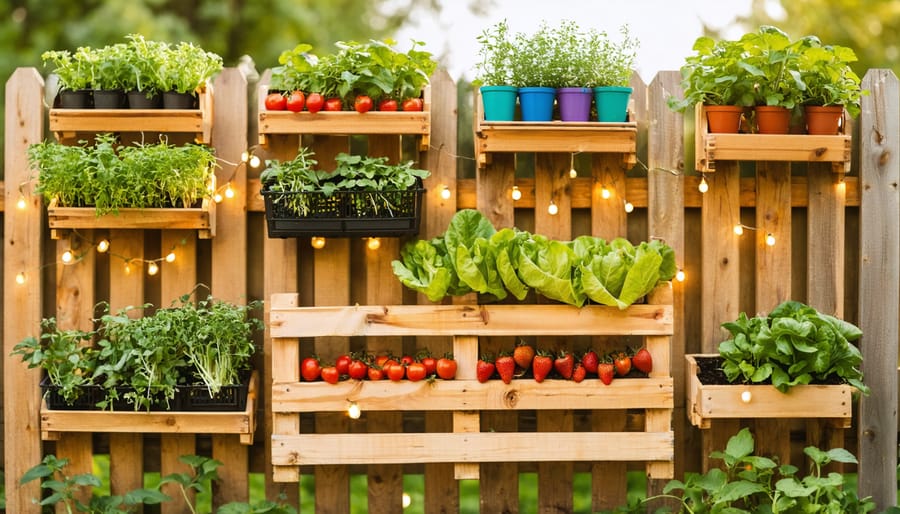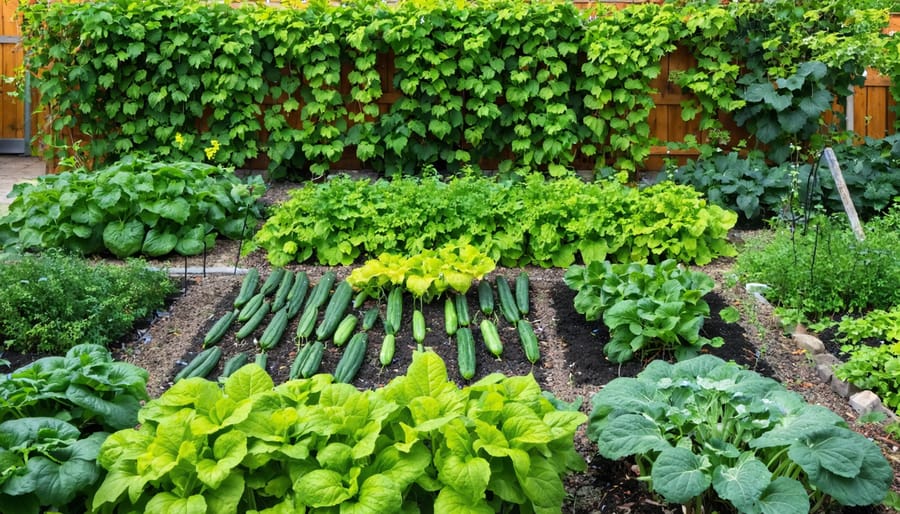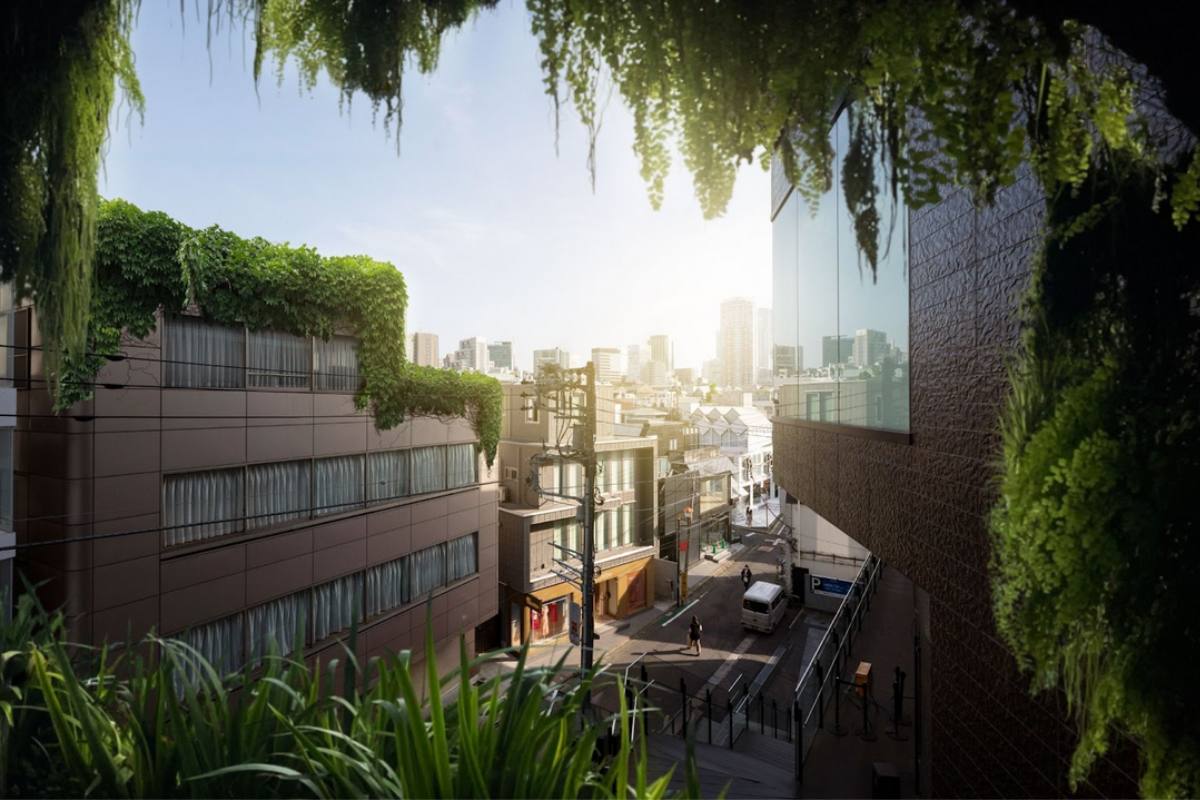Transform your garden into a natural sanctuary by strategically placing large, weathered boulders as striking focal points, layering river rocks in varying sizes to create dynamic pathways, and incorporating delicate pebble mosaics around water features. Rock gardens offer an elegant, low-maintenance solution that brings year-round structure and visual interest to any outdoor space, whether you’re working with a sprawling landscape or a cozy urban garden.
Natural stone elements merge seamlessly with both modern and traditional garden designs, creating stunning contrasts against lush greenery while solving common landscaping challenges like erosion control and drainage. From Japanese-inspired zen gardens to Mediterranean rockeries, these timeless materials provide endless possibilities for creative expression and practical problem-solving in your outdoor space.
Picture smooth granite stepping stones leading through a carpet of creeping thyme, or imagine a dramatic dry creek bed lined with tumbled cobblestones that manages rainfall while adding architectural interest. These versatile elements work in harmony with plants, lighting, and water features to create a garden that feels both grounded and alive with possibility.
Natural Rock Gardens That Wow
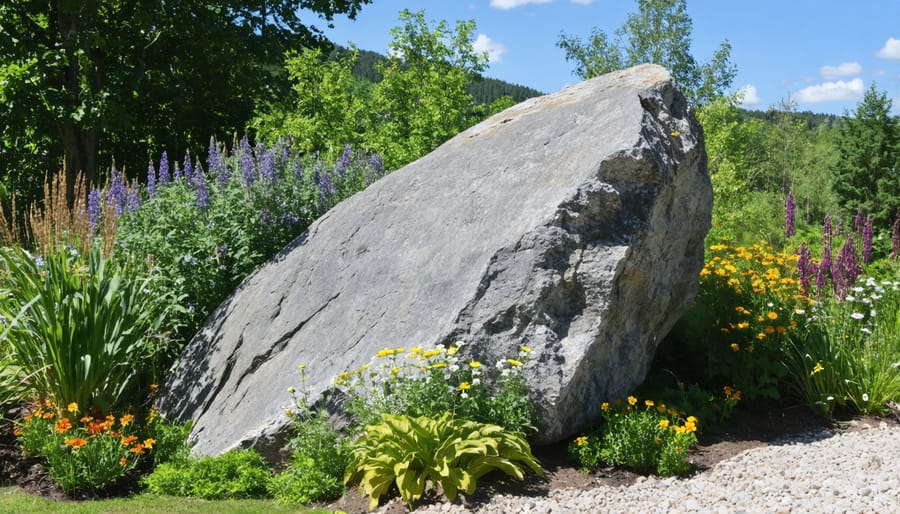
Choosing the Right Rocks
Selecting the right rocks for your garden is like choosing the perfect accessories for an outfit – they should complement your landscape while serving a practical purpose. When planning your rock garden, consider three key factors: size, type, and color.
For size, aim for a mix of different dimensions to create visual interest. Large boulders (2-3 feet across) work as striking focal points, while medium-sized rocks (6-12 inches) are perfect for borders and creating natural-looking clusters. Smaller rocks and pebbles (1-3 inches) are ideal for pathways and filling spaces between native plants.
When it comes to rock types, limestone and sandstone are excellent choices for most gardens, as they weather naturally and provide neutral backgrounds. Granite offers durability and comes in various colors, while slate adds dramatic dark tones and interesting layers. For a more polished look, river rocks provide smooth surfaces and rounded edges that are both attractive and safe for children.
Color selection should reflect your garden’s overall palette. Light-colored rocks like white marble or pale limestone brighten shady areas, while darker stones like basalt create dramatic contrasts against bright foliage. Choose rocks that match or complement your home’s exterior for a cohesive look.
Remember to source your rocks locally when possible – this ensures they’ll look natural in your climate and reduces transportation costs. Visit local quarries or landscape suppliers to see and feel the rocks in person before making your final selection.
Strategic Placement Techniques
When arranging rocks in your garden, the key is to create arrangements that look like nature’s own handiwork. Start by observing natural rock formations in the wild – notice how rocks typically cluster in groups of odd numbers and how larger stones often appear partially buried rather than sitting directly on the surface.
Layer your rocks by placing the largest ones first as anchor points, then work your way down to smaller stones. This creates a sense of stability and visual harmony. When positioning larger rocks, bury about one-third of their height in the ground to achieve that settled, established look that mimics natural formations.
Consider the rule of thirds when placing your rocks: divide your garden space into a grid of nine equal squares and position key stones at the intersection points. This creates a more balanced and aesthetically pleasing arrangement. Group rocks in collections of three or five, varying their sizes while maintaining a consistent color palette or texture theme.
For a natural-looking stream bed effect, arrange elongated rocks with their longest sides parallel to the water flow direction. When creating rock gardens on slopes, position flat rocks at slight angles facing uphill to direct water flow and prevent soil erosion.
Remember to leave enough space between rocks for plants to grow and establish themselves. This softens the overall appearance and creates that perfect balance between structure and nature.
Modern Rock Design Elements
Geometric Rock Arrangements
Geometric rock arrangements offer a stunning way to bring modern sophistication to your garden space. By deliberately placing rocks in patterns like circles, squares, or spirals, you can create eye-catching focal points that add structure and visual interest to your landscape.
Start with a simple circular arrangement using similarly sized rocks placed equidistantly around a centerpiece, such as a striking boulder or water feature. This classic design works particularly well in meditation gardens or as a natural gathering spot in your yard. For a more dynamic look, try creating concentric circles using rocks of gradually decreasing sizes.
Linear arrangements are equally impactful, especially in contemporary gardens. Try positioning rectangular stones in parallel lines to create a rhythmic pattern, or arrange them in a zigzag formation for added energy. These geometric patterns work beautifully as pathway borders or as standalone decorative elements.
For a more complex design, consider creating a spiral pattern using graduating sizes of rocks. Begin with larger stones at the outer edge and work your way inward with progressively smaller pieces. This arrangement style is particularly striking when filled with ground cover plants or colorful gravel between the rocks.
Remember to maintain consistency in your rock selection for the most professional look. Choose stones with similar colors or textures when creating geometric patterns. The key to success lies in precise spacing and careful leveling – take time to ensure each rock sits firmly and maintains the intended pattern.
Consider incorporating lighting to highlight your geometric arrangements after dark. Well-placed outdoor lights can create dramatic shadows and emphasize the careful positioning of your rocks, adding another dimension to your garden’s nighttime appeal.
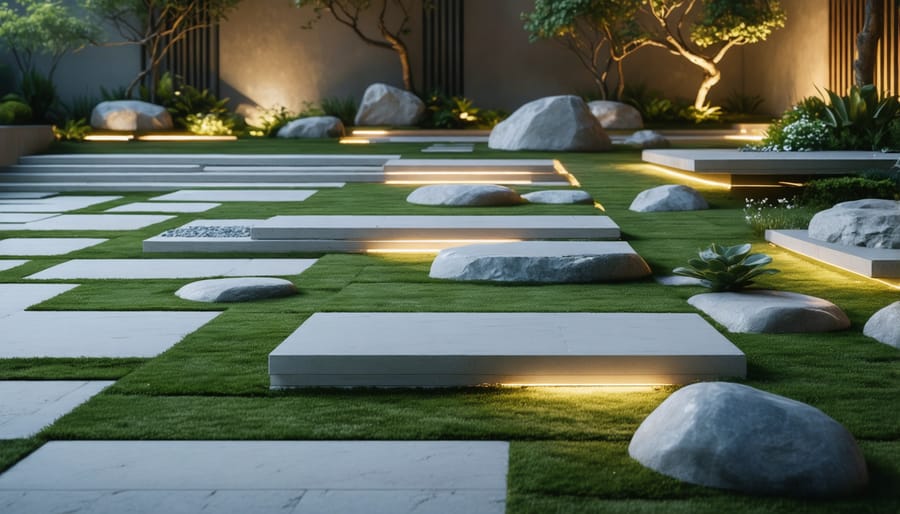
Water Features with Rocks
Water features combined with rocks create a mesmerizing natural sanctuary in your garden, mimicking the serene beauty of mountain streams and waterfalls. By strategically placing rocks around fountains, streams, and ponds, you can craft stunning eco-friendly garden features that celebrate the harmony between water and stone.
For a simple yet elegant fountain display, surround your water feature with smooth river rocks of varying sizes. Layer them naturally, placing larger boulders at the base and gradually decreasing the size as you work upward. This creates a professional look while helping to hide pump equipment and water lines.
When designing a stream, use flat rocks to create small waterfalls and cascades. Position them at slightly different angles to produce gentle water music as it flows downstream. Line the stream’s edges with weather-worn stones and pebbles to achieve an authentically natural appearance.
For pond environments, incorporate both submerged and partially visible rocks to create hiding spots for fish and landing areas for birds. Large, flat stones around the pond’s edge serve as practical stepping stones while adding visual interest. Consider using dark-colored rocks beneath the water’s surface to create depth and contrast.
Remember to include some dry-stacked rock formations near your water feature to tie the entire design together. This helps create a cohesive look and provides additional seating areas where you can relax and enjoy the soothing sounds of flowing water. For maximum impact, choose rocks with similar colors and textures to those found naturally in your region.
Low-Maintenance Rock Gardens
Drought-Resistant Combinations
Creating a drought-resistant rock garden is both environmentally friendly and low-maintenance. The key is pairing your rocks with plants that thrive in dry conditions. Succulents are natural companions for rock gardens, with their striking shapes and minimal water needs. Try combining smooth river rocks with clusters of Sedum or Sempervivum for an eye-catching display that practically takes care of itself.
Ground covers like Creeping Thyme and Ice Plant work beautifully between stepping stones or larger rocks, creating soft carpets of color that can handle foot traffic and drought conditions. These plants will spread naturally, filling gaps and creating a seamless look while requiring minimal water.
For vertical interest, consider pairing tall ornamental grasses like Blue Fescue or Mexican Feather Grass with medium-sized boulders. These drought-tolerant grasses add movement and texture while complementing the solid presence of the rocks.
Lavender and Sage are excellent choices for rock gardens, offering both fragrance and drought resistance. Plant them alongside gravel paths or between larger rocks where their silver-gray foliage can contrast beautifully with stone surfaces.
Remember to group plants with similar water needs together, and use rock mulch or gravel to help retain moisture and reduce evaporation. This combination of thoughtful plant selection and strategic rock placement creates a sustainable garden that looks stunning year-round with minimal intervention.
Smart Spacing and Mulching
Strategic spacing between rocks and proper mulching are essential techniques that can drastically reduce your garden maintenance while creating a polished, professional look. When placing rocks, leave enough room between them to allow for easy mowing and weeding – a good rule of thumb is to space larger rocks at least 24 inches apart. This spacing also creates natural pathways and allows plants room to grow without feeling cramped.
Mulching around your rocks serves multiple purposes. A 2-3 inch layer of organic mulch like pine straw or wood chips helps retain moisture, suppress weeds, and create a clean transition between rocks and plants. Dark-colored mulches particularly complement light-colored rocks, creating striking visual contrast. For areas between rocks, consider using river pebbles or crushed granite as an alternative to organic mulch – these materials last longer and won’t need annual replacement.
To minimize maintenance further, install landscape fabric beneath your rocks and mulch. This extra step prevents weeds from taking root and keeps your rock features looking pristine. When selecting plants to accompany your rocks, opt for low-maintenance varieties like ornamental grasses or drought-resistant succulents. These plants naturally complement rock features and require minimal upkeep, allowing you to spend more time enjoying your garden rather than maintaining it.
Remember to create clear boundaries between mulched areas and lawn spaces using metal or plastic edging. This simple addition keeps materials in place and creates crisp, professional-looking lines throughout your garden.
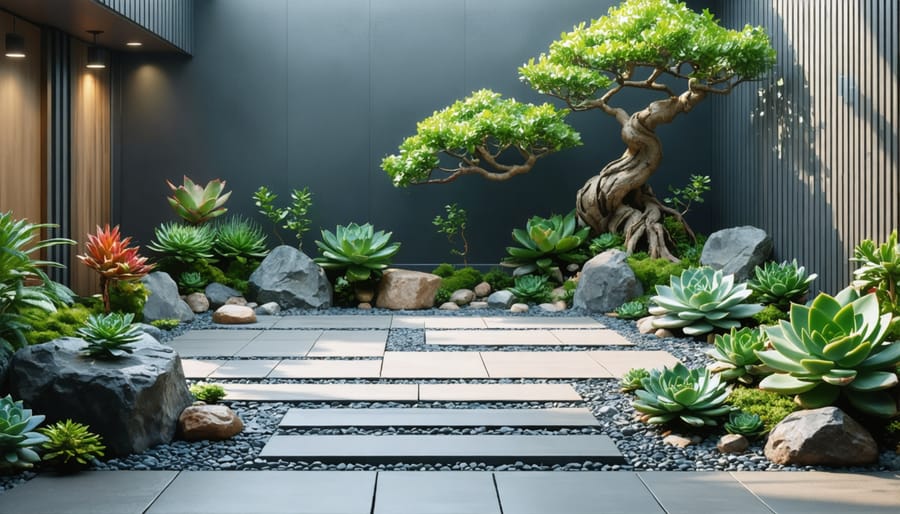
Small Space Rock Garden Solutions
Don’t let a small outdoor space limit your rock garden dreams! With clever small space garden design techniques, you can create stunning rock features that maximize every inch while maintaining visual balance.
Consider creating a vertical rock wall garden by stacking weather-resistant stones of varying sizes. This approach not only saves precious ground space but also adds an eye-catching architectural element to your garden. Tuck small, drought-resistant plants like sedums and sempervivums between the rocks to soften the look and add living color.
Container rock gardens offer another space-smart solution. Choose shallow, wide containers and arrange rocks of different sizes and textures to create a miniature landscape. Mix in small alpine plants and dwarf varieties that naturally grow between rocks. This portable option allows you to adjust your garden’s layout as needed and works beautifully on patios, balconies, or even windowsills.
Make use of corners by creating triangular rock arrangements that draw the eye upward. Start with larger rocks at the base and gradually decrease the size as you build up, creating natural-looking tiers. These corners become perfect spots for cascading plants like creeping thyme or rock cress.
Don’t overlook the power of strategic rock placement. Even a few well-chosen boulder specimens can serve as striking focal points while leaving plenty of room for other garden elements. Consider incorporating a small rock stream bed that doubles as a drainage solution during wet weather.
For truly tiny spaces, try creating a zen-inspired gravel garden with just a handful of carefully selected rocks. Use a rake to create patterns in fine gravel, positioning three to five rocks in an asymmetrical arrangement. This minimalist approach can create a sense of calm and space in even the smallest garden area.
Remember to keep scale in mind – choose rocks that won’t overwhelm your space but are large enough to make an impact. Light-colored rocks can help brighten shady corners, while darker stones create dramatic contrast against bright plants.
As we’ve explored throughout this guide, incorporating rocks into your garden design offers endless possibilities for creating stunning, low-maintenance landscapes that stand the test of time. From elegant Japanese-inspired zen gardens to vibrant rock borders filled with alpine plants, these versatile elements can transform any outdoor space into a natural sanctuary.
Remember that successful rock garden design isn’t just about placing stones randomly – it’s about creating harmony between your rocks, plants, and existing landscape. Start small with a simple rock border or focal point, and gradually expand your design as you gain confidence. Don’t be afraid to experiment with different sizes, colors, and textures of rocks to create visual interest and depth in your garden.
Whether you’re working with a tiny urban courtyard or a sprawling backyard, rocks can help you establish structure, improve drainage, and reduce maintenance while adding year-round appeal to your outdoor space. Consider your local climate and natural surroundings when selecting both rocks and plants to ensure your garden thrives with minimal intervention.
Now that you’re equipped with these ideas and insights, it’s time to start your own rock garden project. Take inspiration from the designs we’ve discussed, but don’t hesitate to add your personal touch. Remember, the best gardens reflect their creators’ unique vision while working in harmony with nature. Happy gardening!


